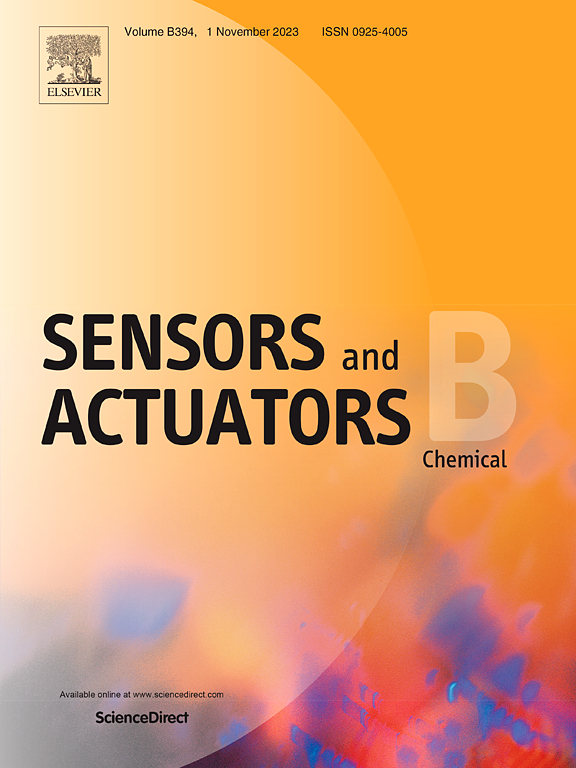Highly atom-economic strip for respiratory syncytial virus detection using an entropy-driven circuit-based one-stone-two-birds strategy
IF 8
1区 化学
Q1 CHEMISTRY, ANALYTICAL
引用次数: 0
Abstract
Lateral flow assays (LFAs) are rapid, inexpensive, and widely used for point-of-care testing (POCT) of viral RNA. However, traditional capture probes, which bind only one type of reporter tag in a single sensing zone, limit amplification efficiency and compatibility with diverse amplification methods. We developed a multi-signal, reverse-transcription-free lateral flow assay for detecting respiratory syncytial virus (RSV) RNA fragments. This assay leverages a chimeric tetrahedral probe combined with an entropy-driven, 'one-stone-two-birds' strategy for enhanced signal amplification. The tetrahedral chimera carries two sorts of capture probes that recognize and capture different signal strand inputs. Entropy-driven circuits (EDC) generate abundant waste chains via a self-feedback cascade reaction, including two biotin-labeled single strands and one duplex. As reporter tags, the two biotinylated single-stranded chains can be simultaneously matched and captured by tetrahedral chimera during one time of sample flow, bridging horseradish peroxidase-coupled streptavidin-modified gold nanoparticles onto the strip to induce coloration. In this process, every EDC cycle can achieve dual signal outputs, akin to "killing two birds with one stone" in the atom-economic signal amplification. Furthermore, the gold nanoparticles carry amounts of horseradish peroxidase, serving as catalytic amplified labels to enhance the colorimetric signal. The strip achieves a broad linear dynamic range and a detection limit of 0.1fM with high specificity for RSV detection. Thus, this lateral flow assay realizes a high atom economy in amplification reaction and offers a rapid, reliable, sensitive, and widely accessible tool for on-site visual detection of viral nucleic acids.
用于呼吸道合胞病毒检测的高度原子经济条带,使用基于熵驱动电路的一石二鸟策略
横向流动测定法(LFAs)快速、廉价,广泛用于病毒RNA的即时检测(POCT)。然而,传统的捕获探针在单个传感区仅结合一种报告标签,限制了扩增效率和与多种扩增方法的兼容性。我们开发了一种检测呼吸道合胞病毒(RSV) RNA片段的多信号、无逆转录的横向流动试验。该检测利用嵌合四面体探针结合熵驱动的“一石二鸟”策略来增强信号放大。四面体嵌合体携带两种捕获探针,可以识别和捕获不同的信号链输入。熵驱动电路(EDC)通过自反馈级联反应产生大量的废物链,包括两条生物素标记的单链和一条双链。作为报告标记,这两条生物素化的单链链可以在一次样品流动中同时被四面体嵌合体匹配和捕获,将辣根过氧化物酶偶联链亲和素修饰的金纳米颗粒桥接在条带上诱导着色。在这个过程中,每个EDC周期都可以实现双信号输出,类似于原子经济信号放大中的“一石二鸟”。此外,金纳米颗粒携带大量的辣根过氧化物酶,作为催化放大标签来增强比色信号。该试纸条具有国外的线性动态范围和0.1fM的检出限,具有较高的RSV特异性。因此,这种横向流动检测方法在扩增反应中实现了高原子经济性,为病毒核酸的现场视觉检测提供了一种快速、可靠、敏感和广泛使用的工具。
本文章由计算机程序翻译,如有差异,请以英文原文为准。
求助全文
约1分钟内获得全文
求助全文
来源期刊

Sensors and Actuators B: Chemical
工程技术-电化学
CiteScore
14.60
自引率
11.90%
发文量
1776
审稿时长
3.2 months
期刊介绍:
Sensors & Actuators, B: Chemical is an international journal focused on the research and development of chemical transducers. It covers chemical sensors and biosensors, chemical actuators, and analytical microsystems. The journal is interdisciplinary, aiming to publish original works showcasing substantial advancements beyond the current state of the art in these fields, with practical applicability to solving meaningful analytical problems. Review articles are accepted by invitation from an Editor of the journal.
 求助内容:
求助内容: 应助结果提醒方式:
应助结果提醒方式:


